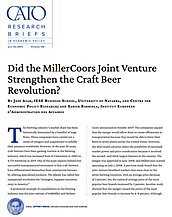The brewing industry’s market share has been historically dominated by a handful of large firms. These companies have carried out a series of mergers and acquisitions to solidify their presence worldwide. However, in the past 20 years, craft brewers have been gaining traction in the brewing industry, which has increased from 413 breweries in 2000 to 4,733 breweries in 2019. One of the main reasons behind this successful entrepreneurial movement is that craft brewers have differentiated themselves from commercial brewers by offering specialized products. The Atlantic has called this unexpected revolution the “strangest, happiest economic story in America.”
A prominent example of consolidation in the brewing industry was the joint venture of SABMiller and Molson Coors announced in October 2007. The companies argued that the merger would allow them to create efficiencies in transportation because they would be able to brew their beers in seven plants across the United States. However, the deal raised concerns about the possibility of increased market power and price coordination because it involved the second- and third-largest brewers in the country. The merger was approved in June 2008, and MillerCoors started operating on July 1, 2008. A previous study found that the joint venture benefited markets that were close to the seven brewing locations, with an average price decrease of 2 percent, but the national average price of the most popular beer brands increased by 2 percent. Another study showed that the merger caused the prices of the most popular beer brands to increase by 6–8 percent. Although the increase in prices for the largest beer brands was adverse for consumers, it may also have encouraged entry by new firms since higher prices make entry more profitable. On the other hand, one could argue that a larger firm has more power to strategically deter entry. It is therefore an empirical question how a merger affects the entry of smaller firms into a concentrated market.
We addressed this question by studying the effect of the MillerCoors joint venture on the number and market share of craft brewers. We used a detailed data set of grocery checkout scans that allowed us to track the evolution of craft beers from 2008 until 2011 in a group of 1,088 grocery stores across 36 states. We found that there is a positive relationship between market concentration and the number of craft brewers active in the market and their market share. Specifically, we have shown that if there is an increase of 0.04 in market concentration (using the Herfindahl-Hirschman Index), which corresponds to the average increase in concentration after the merger, the number of craft brewers increases by 11.59 percent. Moreover, we have shown that this increase in concentration also creates a jump in the craft brewers’ volume share of 0.04 percent. Also, we found that the number of products offered by each craft brewer was not affected by the merger. Therefore, craft brewers’ entry was made easier by the consolidation of commercial brewers, which led to a 1.35 percent increase in the price of commercial beers and a reduction of 0.78 percent in commercial brewers’ volume share. This price increase by commercial brewers may have facilitated entry by small new firms since consumers facing higher prices of incumbent products may be more willing to purchase products that recently entered the market.
NOTE
This research brief is based on José Azar and Xabier Barriola, “Did the MillerCoors Joint Venture Strengthen the Craft Beer Revolution?,” International Journal of Industrial Organization 85 (December 2022).

This work is licensed under a Creative Commons Attribution-NonCommercial-ShareAlike 4.0 International License.
